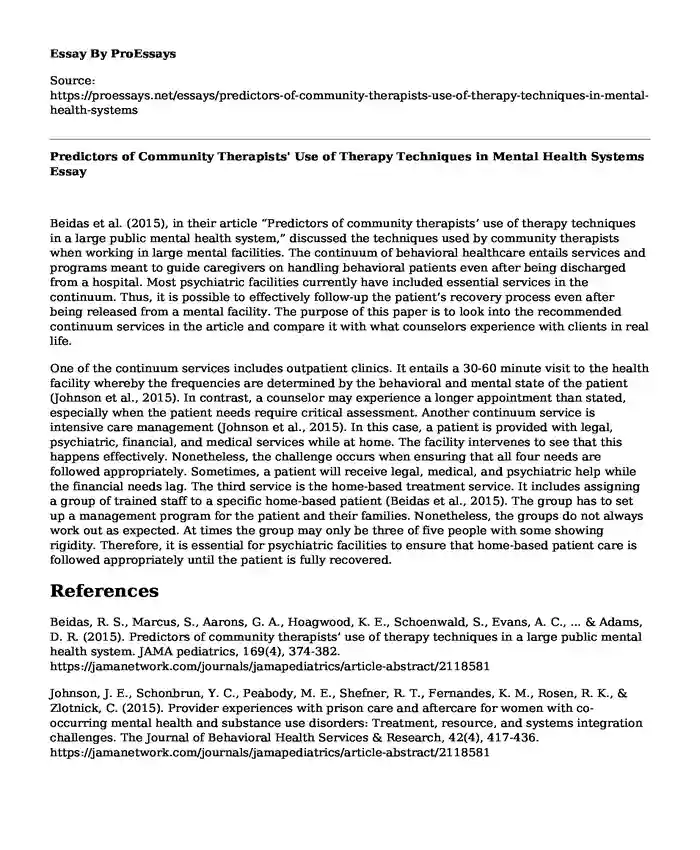Beidas et al. (2015), in their article “Predictors of community therapists’ use of therapy techniques in a large public mental health system,” discussed the techniques used by community therapists when working in large mental facilities. The continuum of behavioral healthcare entails services and programs meant to guide caregivers on handling behavioral patients even after being discharged from a hospital. Most psychiatric facilities currently have included essential services in the continuum. Thus, it is possible to effectively follow-up the patient’s recovery process even after being released from a mental facility. The purpose of this paper is to look into the recommended continuum services in the article and compare it with what counselors experience with clients in real life.
One of the continuum services includes outpatient clinics. It entails a 30-60 minute visit to the health facility whereby the frequencies are determined by the behavioral and mental state of the patient (Johnson et al., 2015). In contrast, a counselor may experience a longer appointment than stated, especially when the patient needs require critical assessment. Another continuum service is intensive care management (Johnson et al., 2015). In this case, a patient is provided with legal, psychiatric, financial, and medical services while at home. The facility intervenes to see that this happens effectively. Nonetheless, the challenge occurs when ensuring that all four needs are followed appropriately. Sometimes, a patient will receive legal, medical, and psychiatric help while the financial needs lag. The third service is the home-based treatment service. It includes assigning a group of trained staff to a specific home-based patient (Beidas et al., 2015). The group has to set up a management program for the patient and their families. Nonetheless, the groups do not always work out as expected. At times the group may only be three of five people with some showing rigidity. Therefore, it is essential for psychiatric facilities to ensure that home-based patient care is followed appropriately until the patient is fully recovered.
References
Beidas, R. S., Marcus, S., Aarons, G. A., Hoagwood, K. E., Schoenwald, S., Evans, A. C., ... & Adams, D. R. (2015). Predictors of community therapists’ use of therapy techniques in a large public mental health system. JAMA pediatrics, 169(4), 374-382. https://jamanetwork.com/journals/jamapediatrics/article-abstract/2118581
Johnson, J. E., Schonbrun, Y. C., Peabody, M. E., Shefner, R. T., Fernandes, K. M., Rosen, R. K., & Zlotnick, C. (2015). Provider experiences with prison care and aftercare for women with co-occurring mental health and substance use disorders: Treatment, resource, and systems integration challenges. The Journal of Behavioral Health Services & Research, 42(4), 417-436. https://jamanetwork.com/journals/jamapediatrics/article-abstract/2118581
Cite this page
Predictors of Community Therapists' Use of Therapy Techniques in Mental Health Systems. (2023, Oct 27). Retrieved from https://proessays.net/essays/predictors-of-community-therapists-use-of-therapy-techniques-in-mental-health-systems
If you are the original author of this essay and no longer wish to have it published on the ProEssays website, please click below to request its removal:
- Maslow Hierarchy of Needs, McGregor Theory and Herzberg Two Factor Theory
- Stress Management Speech Paper Example
- Essay on Gender Differences in Self-Esteem, Anxiety, and Boredom: Considerations for Exercise
- Mental Health Disparities: Certification of Authorship - Essay Sample
- Essay on Incompetence of Andrew Wakefield's Autism
- Paper on Police Undercover Unit Struggles with Stress: A Case Study
- Essay Example on Nurse Burnout: Effects on Patient Outcomes







